Social media has revolutionized the way we shop in 2021.
With billions of daily active users, it's now the perfect place for businesses to sell products. And in turn, it's the perfect place for consumers to engage with brands without subjecting themselves to glossy pamphlets and loud radio ads.
Let's look at what the future of social media eCommerce might look like and learn about the latest trends and opportunities.
Social Media eCommerce Trends For 2022
1. Chatbots On Facebook Messenger
2. Twitter's "Buy Now" Button
3. Instagram's Shoppable Tags
4. Partnering With Micro-Influencers
5. Live Streaming
6. User-Generated Content
7. Augmented Reality
8. Social Commerce
9. TikTok
10. YouTube's "Buy" Buttons
Tips For Embracing New Social Media Trends
1. Choose Trends That Align With Your Audience
2. Increase Sales With Social Media Exclusive Offers
3. Create A Social Media Storefront
Ready To Tap Into The Future Of Social Media eCommerce?
You can directly jump to a section of your choice or keep scrolling.
Social Media eCommerce Trends For 2022
1. Chatbots On Facebook Messenger
Imagine a grocery store where you can do all your shopping on the go accompanied by a cashier who can answer all your questions and help you make sense of the sea of products.
This situation is not far from what chatbots offer! Chatbots can help businesses provide a more personalized experience. And as 66% of customers want brands to cater to their individual needs, it aligns well with the shopping experience consumers want.
Chatbots feels like a natural next step to bring much-awaited convenience to life.
Take Lego's use of chatbots as an example. This bot (nicknamed Ralph) is available to customers 24x7, and it helps people choose and purchase the ideal gift based on the age and interests of the buyer.
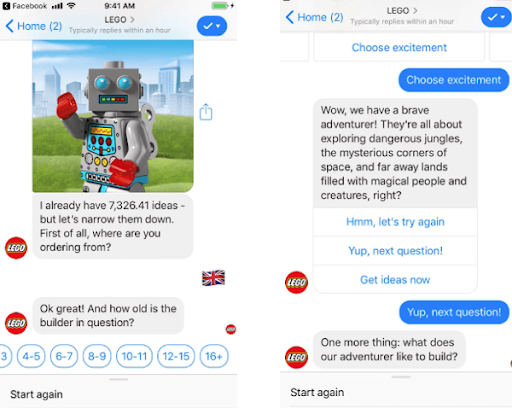
Image Source: SmartInsights
Know more about The Ultimate Guide To Facebook Messenger For Business
2. Twitter's "Buy Now" Button
Twitter used to have a “Buy Now” button that allowed customers to purchase a product directly from a tweet. But recently, Twitter announced that it would start testing a new shopping feature that would allow some US brands to offer shopping on the platform.
As seen in the example below, along with the 'Shop' button, the new eCommerce Twitter card has a product title and code. The card can also list pricing details and display the info sourced from the relevant product page on the brand’s site.

Image Source: Social Media Today
Since they are still in the early stages of development, this example might not truly indicate what Twitter will be able to do one day. Imagine where it will be in five years.
3. Instagram's Shoppable Tags
Instagram Shopping Tags can simplify the communication process between businesses and customers.
With this feature, you can tag products directly in the images and videos you share. Your tags contain all the needed info about the product, including description, features, price, and a purchase link to the seller's site.
Here’s what an Insta post with Shopping Tags looks like:

As you can see in the example above, the shoppable post has the bag icon and the text “View Products.” You can tap on the image to see brief description cards with the product names and costs.
You can also tap on a product to see the seller’s catalog, where you’ll be able to view the description of the item and a website link.
Know more about How To Set Up Instagram Shopping
4. Partnering With Micro-Influencers
In the future of social media, brands will be partnering with micro-influencers and investing in influencer marketing will play a pivotal role for brands and retailers expanding their social media reach. This is because the best way to reach new audiences is by partnering with someone who already has their attention.
Currently, 82% of shoppers are more likely to purchase a product recommended by a micro-influencer. Thus, in 2022 and beyond, larger companies will rely on micro-influencers for sales.
Here’s how the Sperry shoe brand is doing it right.
They launched a two-week influencer campaign that raised awareness for cold, wet weather shoes. To drive engagement, they collaborated with a series of fashion influencers with engaged followings.
As you can see in the image below, these influencers posted their Sperry boots using #OOTD (outfit of the day).

Image Source: ShortyAwards
The campaign was able to gain eyeballs, as the brand partnered with influencers that felt a real connection with the brand and product.
5. Live Streaming
Livestream shopping is a relatively new (but promising!) phenomenon. With it, online shoppers can watch the way a product looks and feels on an actual person, rather than just looking at a picture on their screen.
And it is already big in China, as China's Livestream revenue will hit $281 billion by 2023.
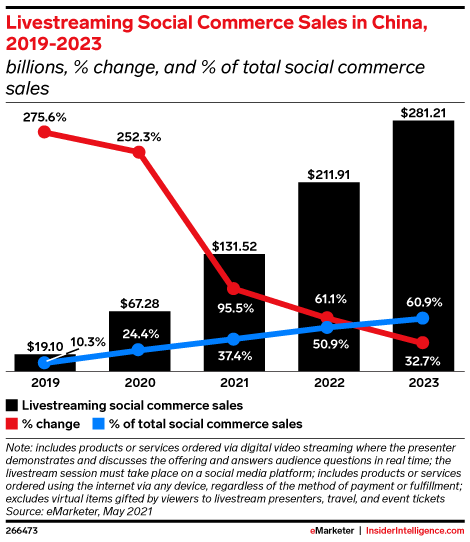
Image Source: eMarketer
Chinese marketers aren't the only ones embracing live sales. Live streams (like Petco’s doggy fashion show) targeting American consumers are increasingly gaining a foothold online.
Facebook recently introduced a running series called Live Shopping Fridays, where brands including Petco and Abercrombie & Fitch sold products on simple live streams and through pre-recorded webinars.
This trend is something to watch out for and try yourself. To start your own live stream sale, prepare a few topics to talk about, find a social media savvy salesperson and use webinar software to host your video.
6. User-Generated Content
Buyers prefer visual and interactive content over traditional content. As per the latest social media statistics, 68% of customers prefer to engage with images. UGC content can give the visual social proof online buyers want.
A drawback with online shopping is that customers can’t physically experience an item before buying it. This is where authentic visuals come in. They offer insight into what a product appears like in real-world situations.
Here’s how Lush featured shoppable UGC from customers on their homepage and product pages:

Image Source: SocialMediaToday
In one month, the linked part of their homepage garnered 1 million impressions. That was a 333% increase from the branded content they previously published. The company also found out that 2% of visitors took action on their Stackla-powered UGC after adding a “Shop Now” button.
7. Augmented Reality
eCommerce through social media has come a long way in the past decade. When businesses first got started using social media, they immediately saw results beyond their wildest imaginations.
Now, businesses are creating fully immersive shopping experiences by following the trend of augmented reality (AR).
For instance, many social networks, such as Instagram Stories, Snapchat, and Facebook, have AR filters. They help you to showcase products and let people test them out in real-time.
Using Filters gives you a competitive edge on social media. They increase audience engagement, and social users will tag you in their content.
Here’s an excellent example of Instagram AR filters from ASOS, a famous fashion store.

8. Social Commerce
Social commerce is the process of selling products directly through social media networks. It allows brands to create seamless eCommerce experiences directly within each social media platform.
You can reach consumers where they are, offer frictionless shopping experiences, and leverage the eCommerce boom with social commerce.
Here’s an excellent example of social commerce from Eureka, a popular furniture store from Australia.

Image Source: TaggBox
They incorporated shoppable Instagram and shoppable UGC galleries on their site. They even created and published shoppable social galleries to boost sales and traction using Taggbox Commerce.
Know more about What Is Social Commerce
9. TikTok
Though TikTok has already crossed a billion active users, its main challenge still lies in effective monetization. Thus, to compete, TikTok needs to facilitate eCommerce and branded partnerships and increase its earnings potential.

Image Source: Social Media Today
TikTok is already working on getting sponsored content through its Creator Marketplace. Users can expect to find even more eCommerce options in the app throughout 2022.
At present, you can use TikTok for sales and targeted lead generation and engage your audience. Even the NBA is leveraging TikTok to engage their target audience.
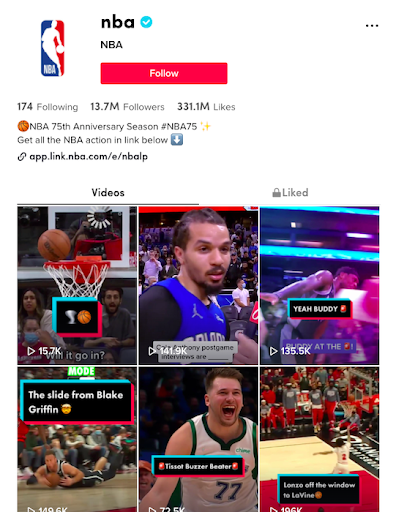
Image Source: NBA
TikTok’s Lead Generation tools also allow businesses to interact with their prospects and convert them into paying customers. Viewers can watch your TikTok video, and if they are interested in your promotion, they can fill out a simple form including name, email, and phone number.
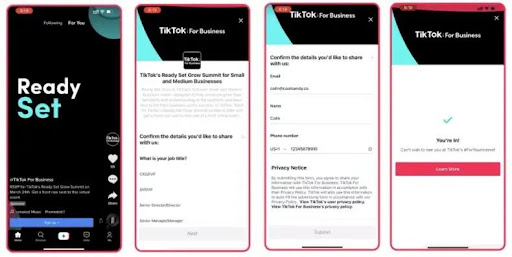
Image Source: ClipChamp
TikTok will automatically populate basic info that viewers give them, offering a great experience. You can then download the lead information or integrate it with your business CRM to gain insights into your prospects.
10. YouTube's "Buy" Buttons
YouTube has been offering advertisers 'click to shop' buy buttons on videos. It is now testing a new feature that allows users to purchase products they see in videos from the platform directly.
According to Youtube, this feature will let viewers get relevant info and buying options for products in videos.
Viewers will see a list of featured products when they click on the shopping bag icon. You will see the icon in the bottom left corner of the video. From here, you can discover each product page and find more info, related videos, and places to purchase the product.
If you want to use this feature, you'll need to partner with an approved creator. Then, you can help them create engaging social media videos that feature your product.
Tips For Embracing New Social Media Trends
Need help embracing these trends in your marketing?
Use these tips to grow your presence, connect with influencers, and gain more traffic and engagement.
1. Choose Trends That Align With Your Audience
Marketing trends and strategies keep evolving. Some trends will be in fashion while some will be out. Naturally, you should check if the platform that your target audience aligns with your brand before developing a strategy for it.
Additionally, make sure you choose platforms that align with your audience. For example, over half of the worldwide Instagram population is aged 34 years or younger. If you were selling to people aged 50+, an Instagram campaign might not reach them.
2. Increase Sales With Social Media Exclusive Offers
Offering exclusive coupons and discounts to your followers is a popular social media promotion trend. And for a good reason: it helps you incentivize people who like or follow you on social media accounts to make a purchase. It also helps you reach a larger audience.
Additionally, you can try cross-posting your offers on each platform to ensure your entire audience sees them. Make sure you add a clear CTA and a hashtag for greater reach.
If you want to see a great example of a social media offer, check out this example from Giselle:
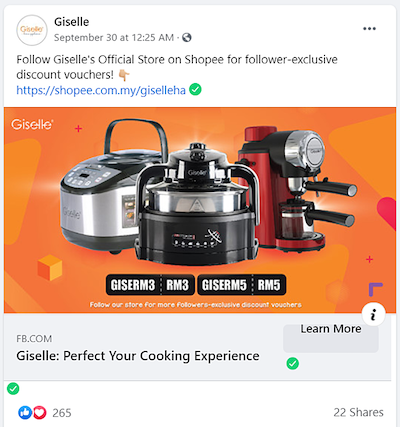
Image Source: Shift4Shop
The famous cooking appliances brand gained traction by offering an exclusive follower-only discount voucher to users who follow their official store. As you can see by the number of likes, it was pretty popular.
3. Create A Social Media Storefront
A social storefront can offer your brand a chance to engage with customers and mold how customers perceive a product, service, or mission.
For instance, if you use Facebook Shop pages, you will be able to create a shop page and curate your product collections. Since these pages load fast and do not force users to leave the app to complete their purchase, they enhance the shopping experience.
The new products you post to your shop get featured on users’ newsfeeds and your brand’s Facebook Shop tab.
And since it offers full-screen images and tailored design features, Facebook Shops helps you to create a brand identity across Facebook and Instagram.
Know more about How To Sell On Facebook
Other shopping-specific platforms like Shopify also have similar features you can use to start an online store to market on social media.
Ready To Tap Into The Future Of Social Media eCommerce?
In this article, we took a look at some of the trends in social media eCommerce and how they could potentially boost your sales.
Traditional media has been slowly shifting to social media over the past decade, and now we have a whole range of new trends that have taken their place in the hype cycle. Naturally, the message is clear: try these trends in your business and watch your sales soar.
Looking for a social analytics tool to track the performance of your social media marketing campaign? Try Statusbrew. With several ready-to-use reporting templates and total flexibility to customize these reports, Statusbrew will help you determine whether your social initiatives have led to positive results and where adjustments are needed to strengthen your marketing campaigns - in no time.
Statusbrew is an all in one social media management tool that supports Facebook, Instagram, Twitter, Linkedin, YouTube, and even Google My Business.




Explore the Statusbrew range of social media tools
Cancel anytime!